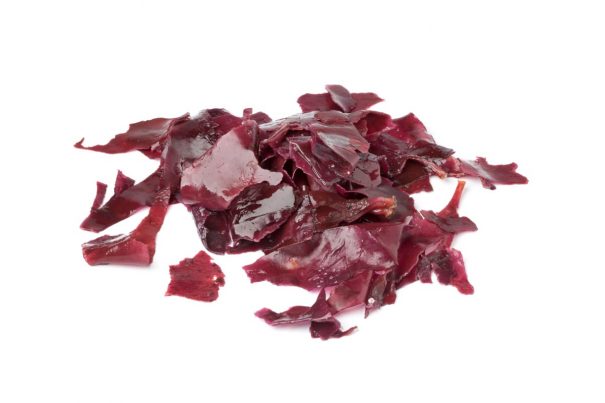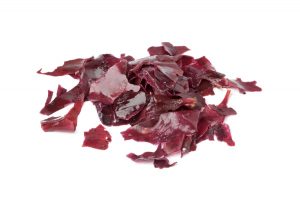
Dulse – sources, health benefits, nutrients, uses and constituents at NaturalPedia.com
Wednesday, July 12, 2017 by Frances Bloomfield
http://www.naturalpedia.com/dulse-sources-health-benefits-nutrients-uses-and-constituents-at-naturalpedia-com.html

Dulse (Palmaria palmate) is a type of edible seaweed that can be found on the Atlantic and Northern Pacific coastlines. In terms of physical appearance, dulse is comprised of a short stem or stipe, and broad fronds or leaves; additionally, dulse can either be red or purple in color, and leathery in texture. Dulse is a well-known snack food in several countries, particularly Iceland where it’s enjoyed as a source of dietary fiber to this day. Apart from dietary fiber, dulse is packed with a multitude of nutrients that have made it a popular choice in culinary and medicinal applications.

List of known nutrients
Dulse contains a wealth of different nutrients, specifically:
- Calcium
- Copper
- Iodine
- Iron
- Magnesium
- Omega-3 fatty acids
- Omega-6 fatty acids
- Polyphenols
- Potassium
- Protein
- Vitamin A
- Vitamin B6 (Pyrodixine)
- Vitamin B12 (Cobalamin)
- Vitamin C
- Vitamin E
- Zinc
Dulse is considered to be a good source of dietary minerals, though it’s especially rich in iron and potassium. Just 3.5 ounces of fresh dulse is enough to provide over 100 percent of the recommended daily values of iron and potassium at 33 milligrams of iron and 1,720 mg of potassium. In fact, the potassium concentration in dulse has been found to be much higher than that of bananas.
The same 3.5 ounce serving of fresh dulse can deliver 6.6 micrograms of vitamin B12 and 21.5 grams of protein, which account for more than 100 percent of the recommended daily value of vitamin B12, and 43 percent of the recommended daily value of protein.
Of all red and green seaweeds, dulse is said to contain the highest amount of polyphenols, or health-promoting micronutrients with antioxidant properties.
Medicinal uses for dulse
Consumption of dulse can alleviate the symptoms of:
- Anemia
- Atherosclerosis
- Bloating
- Constipation
- Cramps
- Diarrhea
- Herpes
- High blood pressure
- Indigestion
- Irritated gums
- Macular degeneration
- Osteoporosis
- Thyroid disorders
Dulse is unique due to its high iodine content, in turn making it a good choice in maintaining a healthy thyroid gland. An under-active thyroid gland can result in a variety of symptoms, such as fatigue, weight gain, depression, and in the case of women, heavy menstruation. However, too much iodine can be toxic and disruptive to the thyroid gland, so keep this in mind when consuming dulse.
Body systems supported by dulse
Eating dulse can be good for:
- Adrenal gland
- Blood
- Digestive system
- Eyes
- Immune system
- Kidneys
- Nervous system
- Thyroid gland
Dulse is an excellent source of dietary fiber, which keeps the digestive system healthy by encouraging regular bowel movement. This, in turn, decreases the chances of developing constipation, diarrhea, bloating, and other digestive disorders.
Ways to use dulse
Unlike other seaweeds, dulse lacks a fishy flavor and instead tastes mild and smoky. This flavor, combined with the numerous health benefits, has made dulse one of the most widely consumed varieties of seaweed.
Dulse can be purchased as a powder, flakes, whole pieces, fresh seaweed, and as extracts or capsules.
Whole and fresh dulse does well in all sorts of recipes, such as salads, omelets, soups, and chowders. Dulse can also be used as a side meat to meat dishes.
The powdered form of dulse can be used as a salt substitute.
Where to learn more
- 8 Benefits of Dulse – Heal Your Body and Digestive System With Dulse
- Dulse is a clinically proven antioxidant, protein source, and plant-based source of iodine and potassium
- Protect against radiation safely and naturally with purple dulse
- Rejuvenate Plus superfood is high in DNA and RNA with sprouts, chlorella and more
- Studies Show That Dulse Is a Great Source of Nutrients and Antioxidants
Summary
Dulse is abundant in nutrients, most notably iron, potassium, vitamin B12, and protein. Moreover, thanks to its iodine content, dulse can support the health of the thyroid gland. When combined with the high amounts of polyphenols, dulse is an incredibly beneficial food that can nourish the body while preventing certain diseases like diarrhea, osteoporosis, and high blood pressure.
Nonetheless, dulse is best consumed in moderation because of its high amounts of iodine, as too much is dangerous and can cause iodine toxicity.
Sources include:
Livestrong.com
ValueFood.info
OrganicFacts.net
HealthyFocus.org
Superfoods-For-Health.org
FoodNetwork.com
Tagged Under: Tags: Dulse





